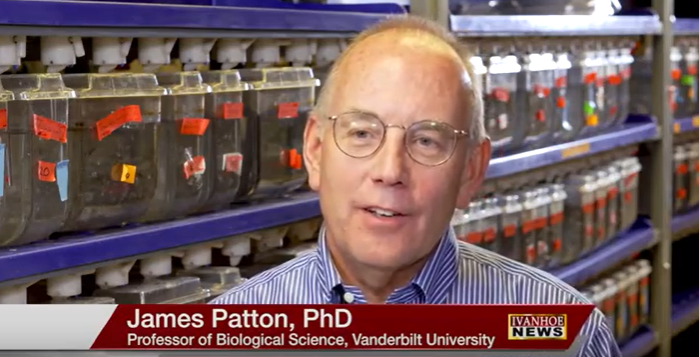James Patton, Ph.D., Stevenson Professor of Biological Sciences at Vanderbilt University, talks about the fascinating abilities of zebrafish, their similarity to humans through a Muller Gila cell, and how the cell may lead to a reduction in vision loss.
Could you tell me about your study on zebrafish and why you’re studying zebrafish?
Patton: Zebrafish are remarkable in their ability to regenerate damaged tissues. We study the retina. The cells that make up the retina between the fish and the human are very, very similar, highly conserved. Yet there is one cell type that in the fish, upon damage, will go backwards in time and become an adult stem cell. Then, it can regenerate itself and generate a population of cells that can go off and replace any lost cell type. One way that we blind them, their photoreceptors will die. Shortly after death, a regeneration cascade from this particular cell type called a Muller glial cell will activate and the Muller glia will give rise to progenitor cells that can replace any lost cell in the eye. The fish will go from blind to total regain of eyesight in about two-and-a-half weeks. In contrast, humans have the same Muller glia but if we have any kind of damage or disease to the eye, we’re incapable of spontaneous regeneration. The goals of our study are to try to understand how the fish retina regenerates and how we could identify ways to trick the human eye to do what the fish eye does naturally.
You said that it regenerated in two-and-a-half weeks, about 20 or so days?
Patton: Yes, about 22, 23, 24 days.
With age-related macular degeneration are there treatments available for people to use and how effective are these?
Patton: For a lot of retinal degenerative disorders at the moment, one of the strategies that scientists are trying to use right now is to inject stem cells into the back of the eye and see if those stem cells will integrate into the retina and then replace lost cell types. This has been going on for eight to ten years and there has been enough progress to keep moving forward, but at the moment, it’s not a complete cure for eyesight. The strategy that we’re taking is to use a stem cell that’s already a resident cell in the eye, in the retina, and see if we can get that cell to become a stem cell and replace all the rest of the lost cells. Whether you have macular degeneration, retinitis pigmentosa, diabetic retinopathy; all of these diseases cause a loss of one or more of the cell types in their retina. Muller glia can replace those lost cells in the fish. At the moment, we can’t understand why that is blocked in humans.
What have you found most surprising about this?
Patton: The most surprising part is that if we use our current tools and we look at Muller glia cell in both the human and the fish and the mouse, they’re very similar. They’re almost identical. It really begs the question of why this can’t happen in the human and why it happens in the fish. One might have guessed that in the fish, we would identify a unique novel gene or pathway that allows the fish to regenerate, but that doesn’t appear to be the case. The pathways and the genes between the fish and the human appear to be very similar, if not identical. There has to be some regulation overlying the whole system in the human that blocks regeneration. We’re studying what unblocks this in fish.
What implications do you believe this will have for the medical world?
Patton: Vision loss moving forward, especially as the human population ages, is an increasing problem, economic loss across the United States and the world. If there were ways to keep people seeing and overcome degenerative disorders, that would have a huge economic impact, not to mention quality of life. Another aspect is as we age, all humans lose rod photoreceptors. It’s a little bit why we don’t drive as well in the dark. We don’t see as well at night. That’s from the loss of rod photoreceptors. Well, conceivably, if that stem cell was constantly replacing photoreceptors or any cell in the eye, we wouldn’t have those deficits as we age.
I know you’re still studying basically why this is happening, but is there anything in particular in that process of trying to find out why that you found to be really fascinating?
Patton: A fascinating question is, you know, since fish and humans are vertebrates, why have fish maintained this ability to regenerate. Not just their retina but you can also sever the spinal cord of a zebrafish and they’ll repair a severed spinal cord. Humans can’t touch that. Even though we’re very similar, both vertebrate animals, why have fish retained this ability to continue to regenerate damaged tissues? And for what reason, what benefit is that accrued to the fish? And why has that been blocked in humans?
Anything that I didn’t ask you that you feel that people should know about this?
Patton: The most recent study that we published is that there’s going to have to be a change in how genes are regulated between the zebrafish and the human. It’s not going to be a question of do humans or fish have a different gene. It’s how are those genes turned on or off as we move between the fish and the human in normal, damaged, or disease states in the retina?
Current treatments out there doesn’t necessarily work for everybody with macular degeneration, can this possibly provide a cure for that?
Patton: Probably not all diseases but for retinal disorders that result in a loss of a specific neuron in the eye, the pathway that we’re studying could conceivably replace those lost neurons.
END OF INTERVIEW
This information is intended for additional research purposes only. It is not to be used as a prescription or advice from Ivanhoe Broadcast News, Inc. or any medical professional interviewed. Ivanhoe Broadcast News, Inc. assumes no responsibility for the depth or accuracy of physician statements. Procedures or medicines apply to different people and medical factors; always consult your physician on medical matters.
If you would like more information, please contact:
Sign up for a free weekly e-mail on Medical Breakthroughs called First to Know by clicking here.




